Roughly 40 AJAC voting members convened at the Hockley Valley resort, northwest of Toronto, for the annual TestFest. Auto manufacturers provided an array of vehicles to be sampled by the assembled AJAC members over Two TestFest drive days. AJAC member votes on the cars driven at TestFest, and other vehicles driven by AJAC scribes during the year, will be tabulated to determine which vehicles get picked for Car of the Year and Utility of the year.
The following are some opinions of the most significant vehicles driven at the TestFest.

The fresh and modern 2025 Nissan Kicks
Nissan Kicks
Nissan keeps the Kicks name for 2025 but appends it to a larger car that replaces the discontinued Qashqai. To keep the budget-friendly market position of the previous Kicks, Nissan has renamed it as the Kicks Play.
The new Kicks is a bit bigger than before and the engine grows from 1.6L and 122 horsepower to 2L and 141 horsepower. With all-wheel drive available for the first time, the Kicks changes categories from a tall hatchback to a crossover vehicle. Nissan’s troubled CVT is the sole transmission offered.
After a decade of retro-frump, Nissan is back in the style game and most of their recent cars have been some of the best-looking in the industry. The new Kicks looks clean, taut and very modern.
The cabin of the new Kicks features a wide and shallow computer tablet that houses vehicle and infotainment displays. Climate is controlled by touch surfaces that work well. Front seats are comfortable and covered in an attractive three-tone cloth and vinyl combo, and there are copious soft-touch surfaces on the dash and front doors. The rear seat is supportive but legroom should be better. The trunk is deep and regularly shaped.
Nissan seems to specialize in offering “just sufficient” power in their cars. The car has enough speed and is quiet when cruising but anything beyond modest acceleration reveals a distressing lack of refinement for what is now an expensive ($27,000 to $40,000) vehicle, and performance that doesn’t measure up to what is expected for the money.
Steering is light and lacks feel but is accurate enough and holds its line on the highway. Like other Nissans, ride is reasonable over a single bump but loses composure over a series of disturbances.
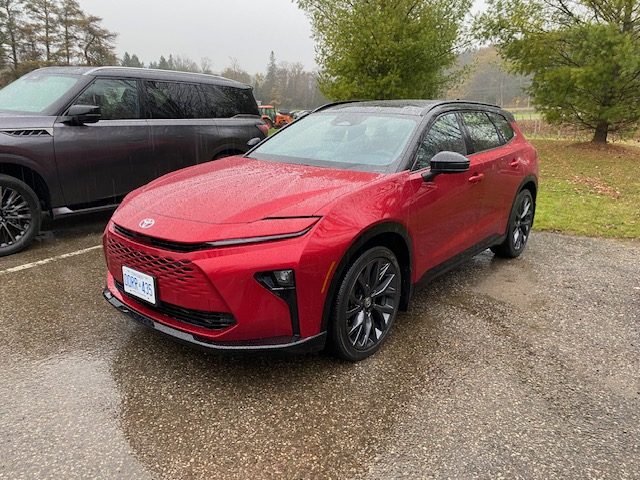
The Toyota Crown Signia wagon is significantly more elegant than the sector-bending Crown sedan
Toyota Crown Signa
A station wagon version of Toyota’s very bizarre Crown crossover sedan. The wagon is very elegant, with clean lines and some nice detailing.
The Signia carries over the cabin from the Crown and is pretty successful. The digital gauge package is reasonably clear and there is a massive touch screen running infotainment functions with the climate controls using a series of physical toggles.
The Signia is very large and roomy front and rear, but the driver’s position feels very tight from door to console, absurdly so for such an enormous car. Cargo space is good.
At a time when they have been critically short of hybrid powertrains in Canada, Toyota has elected to make the Signia exclusively hybrid. The 2.5L four links to electric motors to create 243 total system horsepower. Power reaches the front wheels via a CVT, with the rear wheels driven electrically.
The balance of performance and fuel economy is excellent and the car is refined under gentle acceleration or cruising, but the din under the hood during hard acceleration is too intense for a vehicle this expensive. Steering, braking, ride and handling are all nicely sorted.
Over the last few years Toyota has specialized in disappointing potential customers by announcing cars that were essentially unavailable. Time will tell whether Toyota can actually deliver the Crown Signia in a reasonable time period.
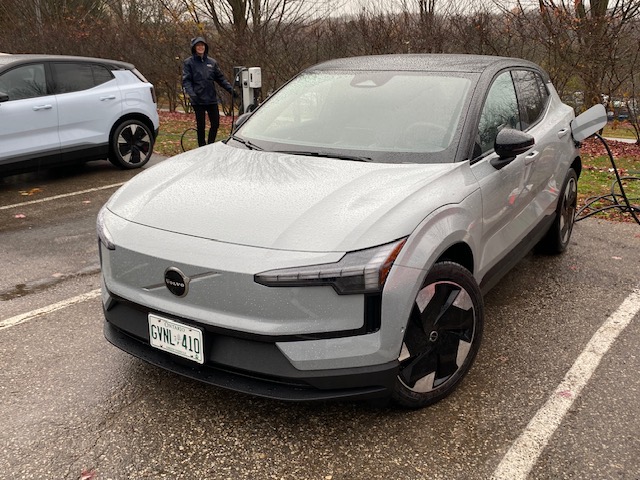
Very fresh. Very Volvo. The Volvo EX30 electric car
Volvo EX30
Volvo’s smallest EV was ensnared in the net of big tariffs against Chinese-built electric cars until Volvo decided to move production to Belgium.
The exterior of the EX30 is chic, modern and very Volvo. The cabin of the EX30, with a visually-calm sense of style that relies on shapes rather than applied ornamentation, is very elegant. Though it looks great, there are too many hard plastic surfaces inside the EX30. Style wise, the cabin is a triumph, but operationally, it is less so. Most functions are run via a centrally-mounted touchscreen, the use of which defines frustration. The front seats are very comfortable, the driving position is very good and space is adequate. That said, the rear seat is oddly shaped, suffers from a distinct lack of legroom and ingress-egress is hampered by a small door.
On the road, confusion starts on entry as there is no start-stop button for the car and the transmission selector makes finding a gear a bit of a mystery. That said, there is little to complain about how the EX30 drives. Our 268 horsepower rear-wheel drive variant (a dual-motor variant with 455 horsepower is available) is fast and quiet. While a bit numb, steering is accurate and the regenerative brakes work very well. Though, firm, the ride is quite resilient and combines with very confident handling.
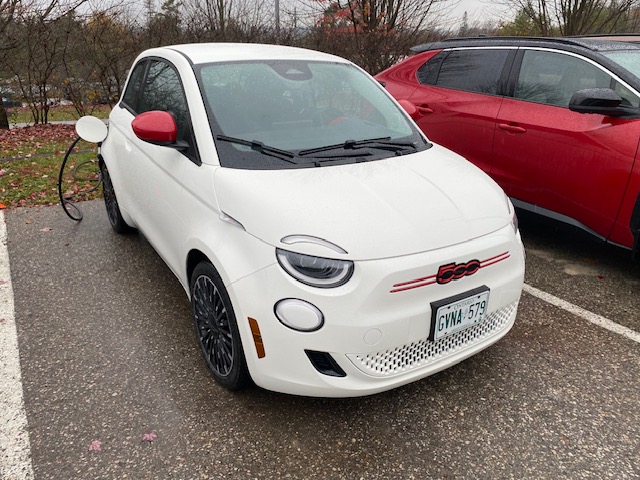
The chic and cheerful Fiat 500e BEV
Fiat 500e
The previous 500e was sold in the U.S. but not in Canada. The new one is built in Italy and up to this point, has been exclusively electric.
Fiat’s dealer network, essentially wound-down several years ago, has been partially revived to market this new 500e. The new Fiat BEV is essentially an electric car meant to calm the wrath of legislators who insist on manufacturers offer a full electric model, rather than a model meant for volume sales.
The 500e is one of the last new cars released by Stellantis not to be based on a universal Stellantis platform shared with Peugeot, Citroen, Opel-Vauxhall and Fiat.
The new 500e is immediately identifiable as a 500, and very very chic.
While still compact, the new 500e is sufficiently bigger than its predecessor to make it genuinely roomy for the two occupants up front. Rear seat room is very tight but trunk space is good enough for careful packers. The cabin looks very upscale. The driver faces a crisply-marked TFT gauge package and the top centre of the dash houses a logical infotainment screen. Cllimate is run by physical toggles. Seats are substantial, comfortable and are covered in a fabric that has Fiat’s logo sewn into it.
The 500e is powered by a 42 kWh battery pack that produces 117 horsepower and has a maximum possible range of 240 kilometers.
On the road, the 500e is quick and very quiet. Steering is accurate and braking is solid. The ride is firm, but seldom jarring and handling is steady. Certainly, the 500e is well suited to its role as an upscale urban runabout.
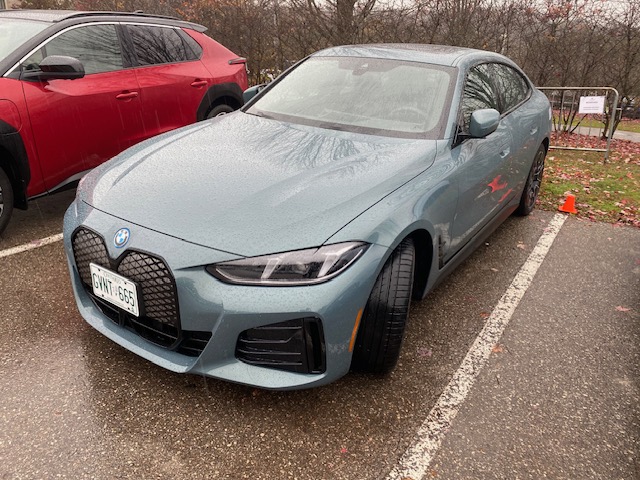
Gigantic grille and fascia piercings mar the otherwise shapely BMW i4 electric hatchback
BMW i4
Dimensionally, the i4 is slightly larger than the conventional 3 Series sedan. The i4 is offered in a truly dizzying and bewildering array of power units. Rear-wheel drive variants are sold as the eDrive 35 (282 horsepower), and eDrive 40 (335 horsepower). The dual-motor all-wheel drive i4s are marketed as the iDrive40 (396 horsepower) and iDrive 50 (536 horsepower). The eDrive 35 is powered by a 68.7 kWh power pack, all other variants employ an 84.3 kWh battery pack.
Like many other BMWs, the i4 is fronted by an oversized version of BMW’s twin-kidney grille that is the antithesis of attractive. Other than the front fender piercings and the odd boomerang-shaped accents on the front fenders, the i4 is elegant and contemporary. The taillights incorporate novel laser light tubes.
Inside, the cabin is dominated by a wide and shallow computer tablet that is fast becoming ubiquitous in cars regardless of market segment. The driver faces a vehicle operation screen of stupendous visual quality, but its design, using vertically arrayed boomerang elements at the edges of the display, is unattractive. The right side of the tablet displays navigation and audio information in its main field. The forward part of the centre console houses a crystal-like gear selector toggle as well as the iDrive controller which combines a rotary dial and buttons for Media, Telephone, Home, Map and Navigation. Cabin materials are plush, with a vinyl called Sensatic, attractive faux-alloy fillets and great lashes of genuine open-pore wood that cover the dash, centre stack and console. The front seats are comfortable, if a bit narrow, and the driver sits low and feels hemmed in by the centre console and door. Access to the front seats is fairly easy but the rear seat makes ingress-egress a bit of an adventure and once in, the seat is oddly shaped and positioned, legroom is tight and there is no room for feet under the front seats. The hatchback trunk is both commodious and luxuriously finished.
Driven in eDrive 40 guise, the i4 is quick and very quiet. Steering is nicely weighted and geared, if slightly numb. Traction is good despite laying down prodigious power to the rear wheels only. Despite the large 19 inch, low-profile tires, the i4 eDrive 40 features a firmly supple ride combined with reassuring handling. The regenerative brakes feel very conventional. Road and wind noise are well suppressed leading to serene progress. The lack of a rear wiper on a hatchback is a bit design oversight.
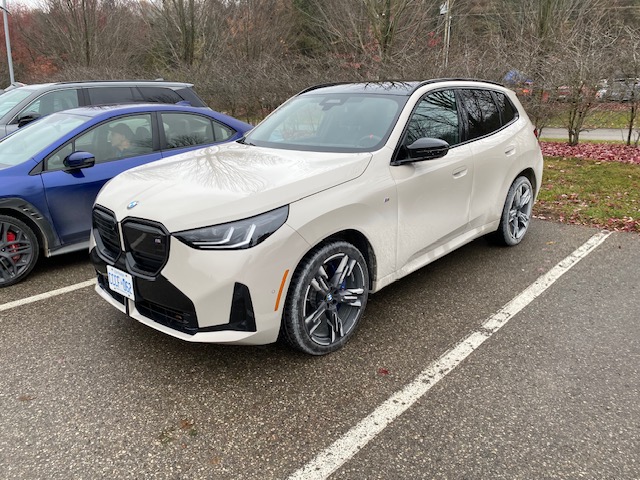
New-generation BMW X3 retains a familiar silhouette but its clean flanks display a new design vocabulary from Munich
BMW X3
BMW supplied an example of its new-for-2025 X3 for TestFest evaluators this year.
Dimensionally the new X3 is unchanged from its predecessor. Engine choices this year include the 2L turbo, marketed as the X3 30xDrive, and the 3L inline six, sold as the M50 xDrive. Both engines feature a mild hybrid system incorporating a 48 volt electrical system.
The 393 horsepower turbo six of the M50 xDrive model provided by BMW is very quick and eager but lacked the silky smoothness expected of an inline six and its exhaust noise is more prominent than desirable.
The steering is nicely weighted and accurate but lacks road feel.
Handling is steady but the ride of the X3 M50 xDrive is disappointing.
Wind and road noise are nicely suppressed but there is a lot of ping from road grit under the car.
The interior reflects a good use of space and room is good front and rear. The seats are comfortable for all occupants. Cargo space is very competitive. The front of the cabin is dominated by the same computer tablet as found in the BMW i4. Like its showroom mate, the graphics of the gauge package are ultra crisp but the actual design of the visuals is unattractive. The cabin styling is generally not pleasing visually. The accent trim on our M50 xDrive model consists of a translucent plastic that can be backlit by a wide array of ambient colours. It is not universally appreciated. There are some very blocky, rectangular shapes on the doors, including large pods at the top front of the front doors containing vents and their fan speed adjusters. Very odd. There are no conventional dash centre vents, just a small, rectangular slot that emits mere whisps of air. Though not visually appealing, cabin trim looks to be good quality. The deep bin at the front of the centre console holds a lot of in-vehicle detritus but again, is visually unpleasant. BMW’s iDrive takes centre stage on the console.
The X3’s exterior reflects a new design language from BMW. The X3’s silhouette is familiar but the surfacing is very clean but some observers thought it looked a bit blobby. The front end features an oversized spin on BMW’s twin kidney grille theme, which is underlined by a mixture of lower air intakes and decorative accents. On the M50, the grille, air intake and piercings are rendered in black with no bright accents, which looks very austere.

The clean-lined, purposeful style of the Toyota Land Cruiser
Toyota Land Cruiser
Initially, there seemed to be a conflict between the Land Cruiser and the upcoming 4Runner, but the Land Cruiser turned out to be so expensive ($70,000+) that any perceived overlap is no longer valid.
The outside of the Land Cruiser is very clean and elegant.
The interior of the Land Cruiser follows Toyota truck design conventions. The driver faces a TFT gauge package with uninspired graphics. The climate controls are all toggle based and work well. The infotainment functions are run via a touchscreen that works well enough. The driver’s seat is comfortable but space between the door and the console is quite restricted for a largish vehicle. Rear seat legroom is less than expected. Cargo space is long and deep but narrow.
On the road, the Landcruiser feels like the body-on-frame vehicle it is. Steering is slightly loose but very accurate and ride and handling are quite truck like. Similar to other body-on-frame Toyotas, the Land Cruiser feels immensely robust but also drives with surprising precision.
The 326 horsepower, hybrid 2.4L turbo four, is not a paragon of refinement but it is strong, eager and is perfectly matched to its eight-speed automatic transmission.
